- Trending:
- Pope Leo Xiv
- |
- Israel
- |
- Trump
- |
- Social Justice
- |
- Peace
- |
- Love

RELIGION LIBRARY
Shinto
Shinto ("the way of the Kami") is the name of the formal state religion of Japan that was first used in the 6th century C.E., although the roots of the religion go back to at least the 6th century B.C.E. Shinto has no founder, no official sacred texts, and no formalized system of doctrine. Shinto has been formative in developing uniquely Japanese attitudes and sensitivities, creating a distinct Japanese consciousness. Belief in kami—sacred or divine beings, although also understood to be spiritual essences—is one of the foundations of Shinto. Shinto understands that the kami not only exist as spiritual beings, but also in nature; they are within mountains, trees, rivers, and even geographical regions. In this sense, the kami are not like the all-powerful divine beings found in Western religion, but the abstract creative forces in nature. Related to the kami is the understanding that the Shinto followers are supposed to live in harmony and peaceful coexistence with both nature and other human beings. This has enabled Shinto to exist in harmony with other religious traditions. As the foundation for Japanese culture, Shinto has also played a significant role in the political realm. For centuries, Shinto religious festivals and ceremonies have become indistinguishable from the affairs of the government.
In this library entry for Shintoism we will explore the following:
Quick Facts
| Formed | -500 |
| Adherents | 3,000,000 |
| Deity | Polytheistic |
| Sacred Text | The Kojiki, The Nihongi |
| Origin | Japan |
| Headquarters | None |










